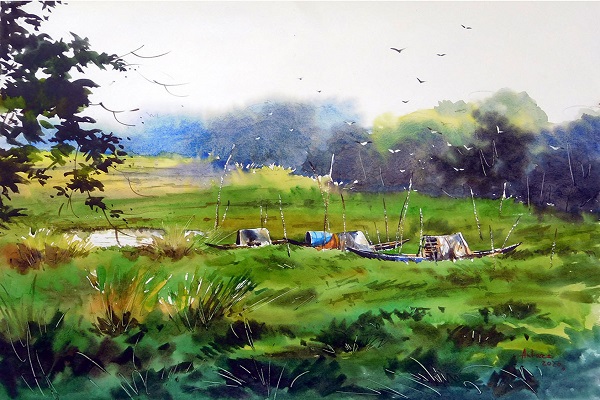
Welcome to the enchanted realm of watercolor paintings, where the imagination has no limitations and the colors flow like rivers. The wet-on-wet technique is one of the many methods used to create these stunning works of art, and it shines out like a sparkling pearl. You'll be mesmerized by the wonderful effects produced by this method as you walk into an Indian art museum filled with magnificent watercolor works.
The wet-on-wet technique is used in watercolor painting to apply wet paint to a wet surface, allowing the colors to mix and merge without effort. A free-flowing paint dance between water and pigments produces the method's distinctive soft edges, ethereal textures, and impression of fluidity.
Wet-on-wet painting captures ephemeral moments and evokes emotions in a way that no other medium can, which is what makes it so beautiful. The artist may convey a sense of newness and spontaneity with each stroke as if the colors were actually alive and breathing. The harmonic transitions between the colors allow the painting to speak in its own language, with each brushstroke telling a unique tale.
We'll explore the fascinating realm of wet-on-wet watercolor paintings in this blog. We'll look at the methods and equipment that painters use to create spectacular effects, learn the science behind how colors and water interact, and learn the strategies and hacks that may help you master this captivating technique. This blog will guide you through the depths of creativity and encourage you to discover the wonder of wet-on-wet watercolor paintings, whether you're a budding artist or simply an art admirer.
Would you want to learn more? Read the blog and let the watercolors' ethereal qualities carry your imagination.
Understanding the Wet-on-Wet Technique
Wet-on-wet painting is an excellent method that is used to create a brilliant symphony of color on a canvas while using watercolors. You'll learn how this method gives watercolor paintings a hint of enchantment as you enter the world of an Indian art museum. So let's go out on a quest to comprehend the fascinating wet-on-wet method.
Wet paint is used to paint on a wet surface using the wet-on-wet technique, which allows the colors to enticingly merge and interact. In contrast to previous methods, this strategy encourages the artist to let go of strict control and embrace spontaneity. Wet-on-wet watercolor paintings have rounded edges, smooth transitions, and a sense of motion that gives the piece life.
Exploring the process of painting wet-on-wet
Wetting the paper with a clean brush or softly misting it with water is the first step in the wet-on-wet painting technique. The pigments can spread and mix more readily thanks to the surface's preparation. The artist carefully paints washes of color onto the wet paper while observing how they seamlessly mix and intermix. It's a dance of colors and water in which the artist directs the movement while also accepting the wonder that happens accidentally.
The wet-on-wet approach assists artists in a variety of ways. It makes it possible to produce delicate, atmospheric effects that are ideal for capturing landscapes, dreamlike settings, and ephemeral moments. This method's spontaneity has the potential to produce unexpected and happy outcomes, offering up new avenues for creative exploration.
But working with wet-on-wet watercolor paintings also comes with a unique set of difficulties. A careful line must be drawn by the artist between directing the flow of paint and letting it act naturally. The window of opportunity for mixing and modifying colors is small, thus timing becomes essential. Additionally, there is always a chance of overworking the painting or losing the necessary form clarity.
Read More: Tips for Artists: Learn the impeccable craft of Watercolor Paintings
Tools and Materials for Wet-on-Wet Painting
It's time to dig into the equipment and supplies that make the wet-on-wet method possible as we continue our tour of the enthralling world of watercolor paintings in an Indian art museum. Let's explore the necessities required to produce magnificent wet-on-wet artworks, from brushes that dance over the paper to paints that explode with bright colors.
Essential materials for wet-on-wet painting
You will want a few essential supplies before starting your wet-on-wet painting voyage. First and foremost, assemble a variety of excellent watercolor brushes. These brushes should have water-retentive soft bristles that hold a lot of them for controlled and fluid painting. You may produce a variety of strokes and features by using different brush sizes.
To mix your paints, you'll next need a palette. Choose a palette with wells for holding the colors and a sizable mixing space. To lift and blend colors on a palette, a palette knife might be useful.
Of course, a colorful selection of watercolor paints is necessary for any wet-on-wet painting to be finished. Invest in professional-grade paints with outstanding lightfastness and a variety of colors. Rich, strong colors that retain their brightness throughout time are provided by these paints.
In order to rinse your brushes between colors, keep a clean water container close by. This prevents unintentional color merging on the palette and guarantees that your colors stay pure and vivid.
Importance of quality brushes and paints
Your brushes and paints have a huge impact on your ability to create wet-on-wet watercolor paintings. It is possible to apply paint more smoothly and with better control when using high-quality brushes with well-shaped bristles. They can produce those lovely flowing washes and delicate mixtures because they can store more water.
Equally crucial is making an investment in high-quality paints. Superior pigments used in the creation of these paints provide increased color intensity and lightfastness. You may easily mix and blend them to produce subtle differences and alluring gradients.
Keep in mind that the instruments you employ are an extension of your imagination. By selecting high-quality tools, you give yourself the freedom to fully utilize the wet-on-wet approach and realize your artistic vision.
Tips for selecting the right paper for wet-on-wet technique
For wet-on-wet watercolor paintings, choosing the appropriate paper is essential. Consider purchasing watercolor sheets made for wet techniques. These sheets are more absorbent, which makes it easier for the paint to spread and mix. Papers that have been cold-pressed or have a rough texture can add visual appeal and provide intriguing effects.
Also, take into account the paper's weight. Papers that are heavier, including those that weigh 300 gsm or more, can withstand the water and paint without buckling or warping.
Be sure to explore while choosing your paper. To choose the one that best matches your preferences and style, try out several brands and varieties. Always keep in mind that the paper you select will serve as the base for your artwork.
Also Check: An Easy Guide to Watercolor Portrait Painting
Step-by-Step Guide to Wet-on-Wet Painting
Wet-on-wet painting possesses a peculiar attraction that draws us further into the mesmerizing world of watercolor paintings. Let's take a step-by-step tour of the fascinating exhibits in an Indian art gallery as we learn about the wonderful wet-on-wet painting technique. We will learn the tricks to this engaging technique, from setting up the paper to producing alluring textures.
Preparing the paper and paints
It's crucial to get your resources ready before stepping into the wet-on-wet environment. If desired, begin by extending your watercolor paper to reduce any buckling or warping. Gather your premium watercolor paints next, and then prepare your palette. Make sure your brushes are tidy and prepared to dance on the page.
Wetting the paper and creating a background wash
It's time to get your creation's canvas ready. Apply a little mist of water or a clean brush to wet the watercolor paper's surface. As a result, the colors flow together and mix seamlessly. Once the paper is sufficiently wet, use broad brushstrokes to provide a soft background wash. To build a foundation that is gentle and harmonic, let the wash run and combine.
Applying wet-on-wet layers and blending colors
Now that the framework has been established, it's time to add color layers to your artwork. Apply the desired shade to the damp area with your brush after filling it with color. Watch as the hues meld and blend to form stunning gradients and rounded edges. To get the desired results, experiment with different brush sizes and strokes. Accept the flow of the medium and let the colors interact and speak for themselves.
Creating textures and effects with wet-on-wet technique
Wet-on-wet painting gives countless opportunities to create eye-catching textures and effects. Investigate several approaches as your painting develops to give depth and visual appeal. To remove paint or add delicate accents, use a dry brush. Water splats may be used to produce intriguing patterns and organic textures on a wet surface. Try experimenting with alcohol or salt to see fascinating flowers and interesting textures. As you investigate the opportunities that wet-on-wet painting affords, let your creativity lead the way.
Techniques for lifting and correcting mistakes
Even in the world of watercolor paintings, mistakes sometimes occur. But do not worry, the wet-on-wet approach offers lifting and error-correcting procedures. Use a clean, moist brush or a piece of paper to gently wipe the excess paint if a color becomes too vivid or if an area has to be adjusted. Carefully remove the paint, taking care not to scratch the paper's surface. Keep in mind that the transparency and flexibility of watercolors are what makes them so beautiful.
Interesting Blog: Living Room Décor Ideas - Landscape Paintings In Watercolor
Exploring the Effects and Applications of Wet-on-Wet Technique
The wet-on-wet approach reveals a plethora of effects and applications that give the artwork life in the intriguing world of watercolor paintings in an Indian art gallery. This method enables painters to render soft, diffused backdrops, capture the ethereal beauty of sky and water bodies, paint loose, expressive flowers, and even transport viewers to moody landscapes. Join us as we investigate the captivating results and numerous uses of the wet-on-wet method.
Creating soft, diffused backgrounds and gradients
Wet-on-wet painting is recognized for its capacity to produce smooth gradients and soft, diffused backgrounds. Artists may seamlessly combine colors by layering wet paint over a wet surface, creating enthralling transitions and ethereal atmospheres. The wet-on-wet method lends itself wonderfully to producing smooth and harmonious backdrops that lure visitors into the depths of the artwork, whether it's a romantic sunset, a foggy countryside, or a subdued backdrop for a composition.
Capturing the beauty of skies and water bodies
Watercolor painters try to convey the mesmerizing attraction of the skies and aquatic bodies. With their fluidity and brilliance, the wet-on-wet method enables the representation of these components' dynamic essence. Artists may conjure forth the immense expanse of a cerulean sky or the soft ripples of a serene lake by deftly stacking wet washes and expertly combining colors. Because the paint imitates the movement and reflections present in the natural world, the technique's inherent unpredictability lends a sense of realism.
Painting expressive and loose florals with wet-on-wet
Wet-on-wet watercolor methods are ideally suited for painting free-form, expressive flowers. The flexibility of the paint enables painters to capture the delicate and bright essence of flowers via organic and spontaneous brushwork. The colors spill into one another with each stroke, giving the work a feeling of movement and vibrancy. The wet-on-wet method allows for free petals, delicate veining, and the elegant flow of floral compositions, embracing the inherent beauty of flaws.
Using wet-on-wet for creating atmospheric landscapes
The wet-on-wet method is an effective tool for capturing moody landscapes. Artists are able to take viewers to far-off landscapes and generate a sense of wonder and tranquillity through the use of soft edges, subtle tone shifts, and layered washes. The wet-on-wet method portrays the movement of light and shadow, the varying colors of nature, and the ethereal moods of landscapes, whether they be foggy mountains or rolling meadows. It enables artists to capture the dynamic beauty of the natural world and invites viewers to get fully immersed in the situation.
Tips and Tricks for Successful Wet-on-Wet Paintings
As we explore the fascinating world of watercolor paintings at an Indian art museum, we come to understand that mastering the wet-on-wet method calls for both dexterity and a dash of magic. To assist you on your creative journey, we've put together a list of essential hints and pointers that will help you master wet-on-wet painting and produce spectacular results. Unlock the secrets of effective wet-on-wet paintings by examining various brush strokes and methods, managing the ratio of water to color, and more.
Controlling the amount of water and pigment on the paper
Controlling the delicate balance between water and pigment is one of the secrets to good wet-on-wet painting. While too little water may prevent the ideal mixing and dispersion of colors, too much water might cause excessive spreading and a loss of control. By regulating the amount of water on your brush and the level of moisture on the paper, gradually raise or reduce the moisture content. Find the ideal balance by taking your time, paying attention to how the paint behaves, and appreciating the spontaneity of the approach while yet being able to control the colors.
Timing and layering techniques for achieving desired effects
Wet-on-wet painting requires precision timing. The secret to getting the desired results is knowing when to add new coats of paint or new colors. Before continuing, let each layer partially dry to make sure the preceding washes have settled and won't be disturbed by the next brushstrokes. You may add depth, make minor differences, and improve the overall visual impact of your artwork by judiciously adding washes. Your persistence and acute observation skills will produce breathtaking outcomes.
Experimenting with different brush strokes and techniques
The wet-on-wet approach opens up a world of brushwork and technique possibilities. Try with different brushstrokes, from broad and sweeping to fine and controlled. Investigate the results of scraping paint off with a dry brush, generating textures with a damp sponge, or even adding salt or alcohol to produce eye-catching patterns. Allow your brush to become an extension of your ideas and dance across the wet surface to produce one-of-a-kind, mesmerizing effects that give your artwork life.
Avoiding common pitfalls and challenges
Wet-on-wet painting is a captivating technique, but it also has several frequent drawbacks and difficulties. Try not to overwork the painting; this might cause muddy colors and a loss of clarity. Accept the technique's unpredictable nature, but keep some degree of control by organizing and visualizing the intended result. Consider the absorbency of the paper and adjust as necessary. You can overcome these difficulties and take your wet-on-wet paintings to new levels with practice and perseverance.
Read More: Exploring the Advantages and Disadvantages of Buying Watercolor Paintings Online
Final Thoughts
We leave our investigation of the captivating wet-on-wet method in the enthralling world of watercolor paintings at an Indian art museum with a deep respect for the magic that takes place on the canvas. The wet-on-wet technique gives artists a means to freely and spontaneously express their ideas while producing mesmerizing works of art that spark people's imaginations and elicit strong feelings.
We urge you to start your own wet-on-wet painting experience, dear reader. Accept the technique's unpredictability since it is in the haphazard brushstrokes and blending of colors that the true enchantment of watercolor paintings emerges. Let go of your preconceived notions, go with the flow, and let the brilliant hues dance on the wet canvas.
We provide you with a few last pointers before you set off on your journey. Always start with top-notch supplies because they will serve as the building blocks for your artwork's success. Be patient and mindful, and wait until each layer has partially dried before adding fresh washes. To fully utilize the wet-on-wet approach, experiment with various brush strokes, methods, and results. Most essential, trust your gut and let each brushstroke express your distinct artistic identity.
Your abilities and confidence will advance as a result of your patience and determination. Don't let obstacles or unforeseen events demotivate you. Instead, think of them as milestones in your creative journey. Accept learning as it comes and enjoy the experience.
Visit IndianArtIdeas if you're looking for more ideas or a place to display your watercolor artwork. IndianArtIdeas, a leading online art gallery, offers a platform for artists to showcase their abilities, interact with art fans, and discover a world of creative possibilities. IndianArtIdeas provides a welcoming community and a venue for showcasing your wet-on-wet creations, regardless of your level of experience as an artist or where you are in your creative discovery.
So, let your love for art be sparked and driven by the enchantment of wet-on-wet watercolor paintings. Let your creativity go wild, accept the spontaneity of the process, and produce works of art that capture people's hearts and minds.
Start your trip now and show the world the stunning beauty that results from the blending of colors and the life-like quality of the canvas in the world of watercolor paintings.





















